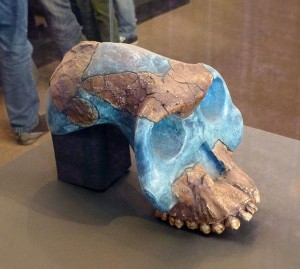Part IV: Pleistocene Epoch
20. Australopithecus garhi
Australopithecus garhi (2.5 mya)
(“southern ape” / “surprise” in the Afar language)

SITES
Bouri site in the Middle Awash area of the Afar Depression, Ethiopia
PEOPLE
Tim White and Berhane Asfaw
INTRODUCTION
In 1996, researchers recovered portions of the frontal and parietal bones as well as a maxilla that contained teeth (see Figure 20.1). These materials were attributed to Australopithecus garhi. While nearby limb bones could not be attributed to the species with absolute certainty, they have been used by some paleoanthropologists to describe the species’ characteristics. Thus there is very little useful material to “reconstruct” this species. Fossil-containing sediments also contained bones with cut marks and a few surface cores (shaped and modified rock) and flakes (sharp pieces of rock struck from a core) were found, suggesting that Au. garhi butchered animal remains and possibly made tools. However, tools in fossil-bearing layers would be better evidence. Some believe that the manufactured stone tools at the nearby Gona, Ethiopia, site may have been manufactured by Au. garhi.
PHYLOGENY
The species is likely descended from Au. afarensis, possibly directly so. Like Au. afarensis, Au. garhi is thought to have been more terrestrial than the South African australopiths. As is the case for the rest of the australopiths, some researchers believe them to be ancestral to genus Homo, and what little evidence there is for tool manufacture accords with our lineage.
DISCOVERY AND GEOGRAPHIC RANGE
The species was discovered in 1996 by Tim White’s crew, and later Berhane Asfaw became involved. The only fossil material comes from the Bouri site in the Middle Awash region of the Afar Depression in Ethiopia.
PHYSICAL CHARACTERISTICS
The maxilla and teeth are larger and more robust than those of Au. afarensis, and some researchers lump them with the paranthropines. Thus like Au. aethiopicus and P. boisei, Au. garhi were adapted to a broader dietary niche in response to environmental changes, particularly expanding grasslands. If the limb bones are rightfully attributed to the species, they had longer, more humanlike legs than other australopiths. Their arms were still apelike, based on the ratio of the arm to forearm length. The cranial capacity was 446 cc, falling midrange within that of Au. afarensis.
Review of Primitive Characteristics
- Ape-like arms.
- Small brain.
Review of Derived Characteristics
- Robust craniofaciodental characteristics.
- Possibly longer, more human-like legs.

